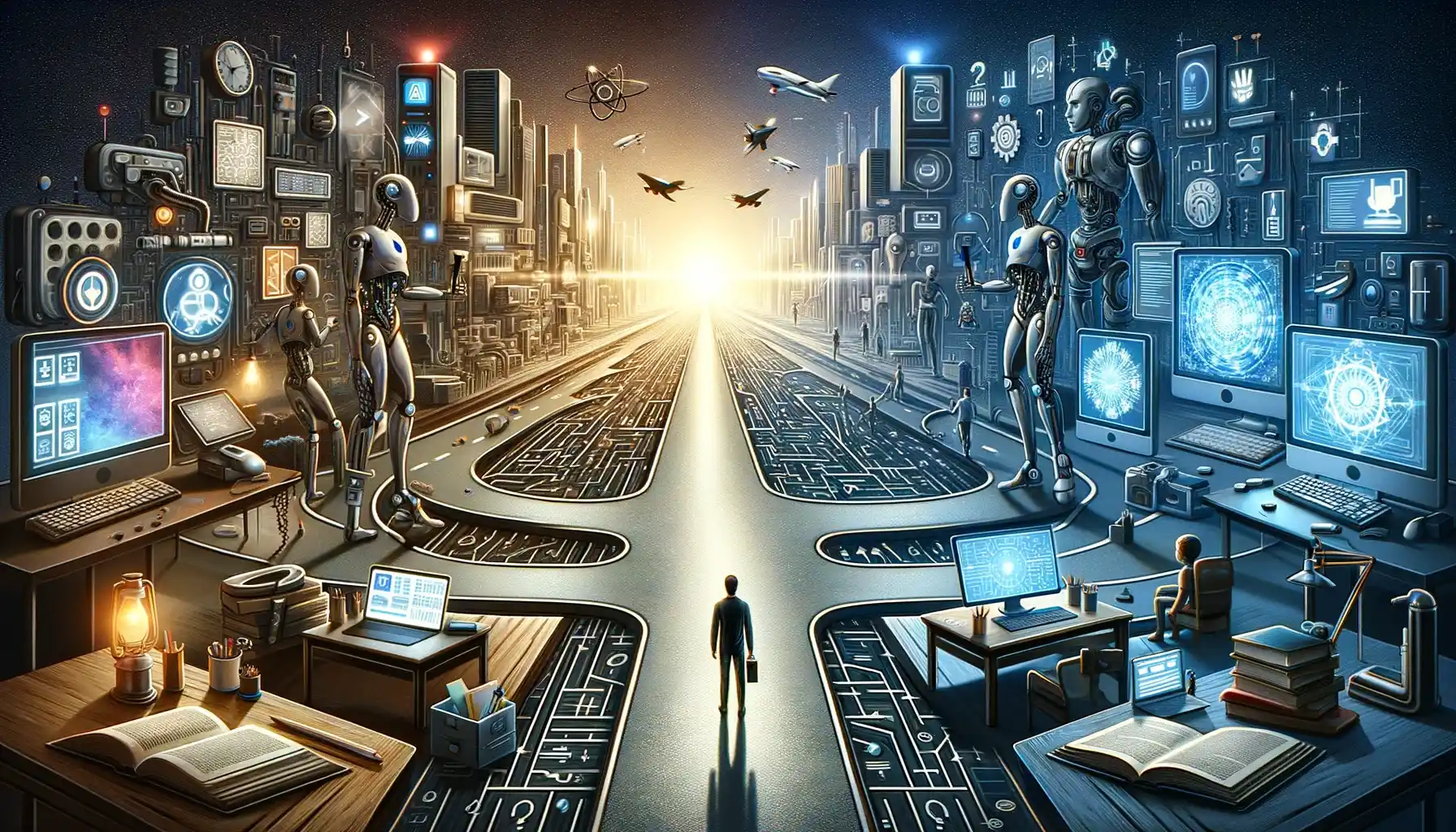AI or Not AI Navigating the Landscape of Technological Choices
Technology is like a superpower that can change how things work in businesses, schools, healthcare, and entertainment. It makes stuff better, faster, and more creative. For example, it improves products, makes things more diverse, and keeps customers happy.
But there’s a flip side. Technology can also bring problems like privacy issues, security concerns, and changes in how people work. One big deal right now is artificial intelligence (AI), which can make things like pictures and videos using fancy computer stuff.
So, it’s crucial to be smart about the tech choices we make and understand what they mean for us.
What is AI and why is it important?
AI is like a smart computer that can do things humans usually do, like learning, thinking, and making decisions. It can also make things that look and sound real, such as pictures, videos, and sounds, using data and computer rules. Plus, it keeps getting better by learning from more data. AI has lots of good things it can do for us.
Automated content creation:
AI is like a creative computer that can make things like pictures, videos, and sounds. It uses fancy tech tools like machine learning and neural networks to understand and create stuff. It can also look at data and tell us interesting things, and it uses other tools like computer vision and speech recognition to understand and play with data.
Data analysis and customer insights:
AI acts like a detective for businesses, looking at things like pictures, videos, and sounds. It uses smart tools like machine learning and neural networks to understand and give advice based on the info it finds. It also uses tools like data and analytics to gather and process information about what customers like and want. This helps businesses offer personalized and relevant suggestions or solutions to customers.
Engagement and customer interaction:
AI is like a friendly helper that talks and interacts with people. It uses cool tech like understanding and producing natural language (like text and speech) to chat with customers and users. It can answer questions, give suggestions, or solve problems. AI also uses other tech, like virtual reality and augmented reality, to show realistic and interactive things. It can adapt and respond to how people interact, making it feel more like a real conversation or experience.
Challenges and Risks
AI can also pose various challenges and risks, such as:
Privacy and security issues:
Privacy and security issues are about keeping people’s personal information safe and respecting their privacy. This includes things like photos, videos, and audio that might be used to make or target AI content. Problems can happen when people don’t know or agree to their personal info being used, or if it gets stolen or misused by bad guys. This misuse might lead to things like identity theft, fraud, or blackmail.
Ethical considerations:
Ethical considerations involve thinking about what is morally right or wrong and considering the values and norms of people and society. This includes concepts like fairness, justice, and responsibility. Ethical issues may come up when people are not aware of or informed about the effects of creating or using AI content. Problems can also arise if the creation or use of AI content goes against the rights and interests of people or harms them in some way. This could involve things like deception, manipulation, or exploitation.
Potential risks in AI representations:
The dangers in AI representations are about how accurate and real the AI content, like pictures, videos, and sound, turns out to be. This depends on the information, algorithms, and models used to make the AI content. Sometimes, these can show or copy biases, like racial or gender biases, from the data and algorithms. These risks can make the AI content less fair, diverse, or accurate. It can harm people and society by causing discrimination, exclusion, or spreading wrong information.
What are the non-AI technological options and why are they important?
Non-AI technological options are the usual tools we’ve been using for a long time to make and change data and content, like photos, videos, and sounds. We do this by hands-on or partly automated ways, like editing, cutting, or adding filters. These traditional methods have their good points and limits.
Advantages of non-AI solutions:
Non-AI solutions come with several benefits. They are often simple and reliable, making them easy to use and understand. These solutions can consistently produce predictable results. Additionally, they offer control and transparency, allowing users to have more influence and visibility when creating and modifying data and content. This helps ensure the privacy and security of users’ personal information and data.
Limitations of non-AI solutions:
Non-AI solutions come with certain drawbacks. They can be time-consuming and expensive to create and modify data and content. Providing this data and content to customers and users may also take a considerable amount of time and money. Additionally, non-AI solutions may have limitations in terms of quality and diversity. They might struggle to achieve high quality and diverse results in the data and content they produce.
What are the considerations in choosing technology and why are they important?
When deciding on technology, the considerations involve the factors and criteria that help users make informed choices in the technological landscape. These considerations help users understand the features, functions, and implications of different technologies, enabling them to make well-informed decisions based on their needs and preferences.
Identifying specific business or personal needs:
Users need to pinpoint their particular business or personal requirements, considering factors like the purpose, goals, and objectives of the data and content. It’s essential to understand the target audience, market, and context surrounding the data and content. Based on these considerations, users should select the technology that aligns best with their needs. This could involve choosing between AI or non-AI solutions.
Budget considerations:
Users need to think about their budget, including the resources, funds, and time they have available. It’s important to weigh this against the expected return on investment. Users should then pick the technology that aligns with their budget. This could mean choosing between AI or non-AI solutions.
Scalability and future-proofing:
Users need to think about whether the technology they choose can grow with their needs and stay relevant in the future. This involves considering if it can handle more demand, a larger amount of data and content, and increasing complexity. It’s also important to check if the technology can adapt to changes in trends, preferences, and expectations from customers and users. Users should then select the technology that offers good scalability (ability to handle growth) and future-proofing. This choice might involve selecting between AI or non-AI solutions.
How to compare DeepBrain AI Alternative and DeepBrain AI Avatar?
DeepBrain AI is a company working on an advanced AI platform. This platform helps users create and use lifelike and expressive data and content, like images, videos, and sounds, for different purposes. To do this, the platform combines AI and ML technologies, including computer vision, natural language processing, speech recognition, and speech synthesis. It’s designed to capture and replicate the physical and behavioral traits of users and various topics.
What’s cool is that users can personalize their data and content and apply them in different areas like entertainment, education, and communication. DeepBrain AI’s goal is to make AI data and content accessible to everyone and make the experience enjoyable and smooth for users. They want to empower users to have a great time with AI data and content.
DeepBrain AI offers two main products, DeepBrain AI Alternative and DeepBrain AI Avatar.
DeepBrain AI Alternative:
DeepBrain AI Alternative is a tool that helps users create and use different data and content, like images, videos, and sounds. This alternative content can either replace or add to the original data and content, such as photos, videos, and audio. This is especially handy when the original stuff isn’t available, suitable, or wanted. For example, it could be useful for celebrities, politicians, or friends. The tool is also great for expressing, sharing, or communicating opinions, emotions, or experiences.
Using DeepBrain AI Alternative comes with various benefits. It can enhance the quality, efficiency, and productivity of online activities. It does this by using high-quality data, algorithms, and models that can capture and reproduce details, nuances, and dynamics related to users and topics. Additionally, it helps in saving costs and time.
Conclusion
In conclusion, technology is a big deal in many areas like business, education, health, and entertainment. It can be super helpful by making things better, faster, and more creative. But there are also challenges, like privacy issues and changes in how jobs work. We need to be smart about the tech choices we make and understand what different technologies can do.
One cool technology is artificial intelligence (AI), which can create and change realistic data like pictures and videos. AI has good parts, like making things automatically and understanding what people want. But it also has challenges, like privacy problems and making sure it’s fair.
There are also other non-AI technologies that work in more traditional ways. They can be simple and reliable, giving us control over what we do. The choice between AI and non-AI tech depends on what we need, how much money we have, and what might happen in the future.
There are also other non- AL technologies that work in more traditional ways. The can be simple and reliable, giving us control over what we do .

Shahid Maqsood, an MBA and Master in Mass Communications, is a seasoned writer with over a decade of experience. Specializing in news and celebrity coverage, he brings a unique perspective from his love for hunting and camping. His work spans multiple platforms like dosttrusty.com and newsbreak.com,Quellpress.com , airriflehunting, and bruitly.com showcasing his versatility and depth. Shahid’s insightful articles reflect his expertise, authoritativeness, and trustworthiness, making him a respected and reliable voice in digital content creation. His contributions engage and inform readers, embodying professionalism and passion in every piece.







